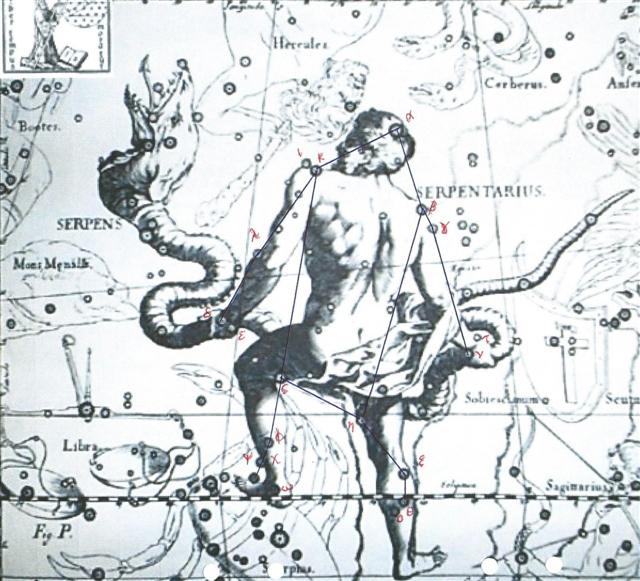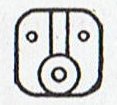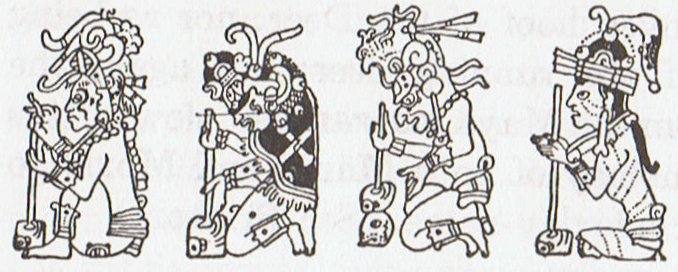In C there is no Rogo glyph with a perfect circle inside. But there is a honui glyph with such a circle, viz Ca9-17:
| November 20 |
21 |
22 |
23 |
24 (328) |
| May 22 |
23 |
24 |
25 |
26 (146) |
 |
 |
 |
 |
 |
| Ca9-16 |
Ca9-17 |
Ca9-18 |
Ca9-19 |
Ca9-20 (248) |
| E rima ki te henua |
koia ku honui |
erua maitaki |
ko koe ra |
| ψ Scorpii (244.6), Lesath (244.8) |
χ Scorpii (245.1), Yed Prior, δ Tr. Austr. (245.5) |
Yed Posterior, Rukbalgethi Shemali (246.6). δ Apodis (246.7), ο Scorpii (246.8) |
Heart-5 |
ρ Ophiuchi (248.1), Kajam (248.3), χ Ophiuchi (248.5), She Low, ι Tr. Austr. (248.7), ζ Tr. Austr. (248.8) |
| σ SCORPII (247.0), Hejian (247.2), ψ Ophiuchi (247.7) |
| Beid (62.2) |
Al Dabarān-2 |
Hyadum II (64.2) |
Net-19 |
no star listed |
| HYADUM I (63.4) |
θ² Tauri, AIN, θ¹ Tauri (65.7) |
| January 11 |
264 |
October 3 (276) |
48 |
November 21 (325) |
 |
 |
 |
| Gb1-3 |
Cb7-26 |
Ca9-17 |
| CASTOR (113.4) |
314 |
January 12 (where 112 = 8 * 14) could have been counted as day 366 + 12 = 378 = the synodic cycle of Saturn.
|
Synodic period |
Orbital period |
|
Mars |
779.96 |
1.88 years |
687 |
|
Mercury |
115.88 |
0.24 years |
88 |
|
Jupiter |
398.88 |
11.86 years |
4332 |
|
Venus |
583.92 |
0.62 years |
227 |
|
Saturn |
378.09 |
29.46 years |
10760 |
| January 10 |
11 |
12 (377) |
13 |
14 |
| July 11 |
12 (193) |
13 |
14 |
15 |
 |
 |
 |
 |
 |
| Cb11-17 |
Cb11-18 (662) |
Cb11-19 |
Cb11-20 |
Cb11-21 |
| e ika |
tagata - henua hikihiki |
te inoino - ka hoi ia |
ku hurihia mai te tagata |
tagata iri |
| Albireo (295.5) |
μ Aquilae (296.3), ι Aquilae (Ant.) (296.8), κ Aquilae (Ant.) (296.9) |
ε Sagittae (297.1), σ Aquilae (Ant.) (297.4), Sham (297.8), |
β Sagittae (298.0), χ Aquilae (298.3), ψ Aquilae (298.8) |
υ Aquilae (299.1), Tarazed (299.3), δ Sagittae (299.6), π Aquilae (299.9) |
| Ghost-23 |
Al Dhirā'-5 / Punarvasu-7 |
Markab Puppis (114.7), Procyon (114.9) |
α Monocerotis (115.4), σ Gemini (115.7) |
Pollux (116.2) |
| ρ GEMINI (112.1) |
CASTOR (113.4) |
Possibly Ca9-17 refers to the Hyadum 'door' which was visible close to the Full Moon. But on the other hand the 'birth' (hanau) should rather refer to the situation south of the equator, when the Sun rose at the Yed 'door' in late November and 4 days earlier than Antares.

Yed Prior is δ Ophiuchi and Yed Posterior is ε Ophiuchi, which together were describing the left hand of the Serpent Carrier.
Instead of a towel this person carries a live serpentine beast, but the composition is obviously similar - though opposite, with the Yed pair grasping in contrast to μ Aquarii which is grasped, and with Aquarius looking ahead while Ophiuchus is looking towards the past.

North of the equator late November is dark and cold. Once upon a time, when heliacal Antares was close to the equinox, the Yed door would have been a door of exit for the Sun, a door leading away from summer.
Hercules is here tumbling upside down. But for an observer south of the equator it would have been the opposite, with Hercules on his feet and Ophiuchus upside down.
There is more. Yed means 'hand' and the 'grasping hand' was Chikin among the Mayas:
| ... The open right hand of Blood Moon receives the 'spittle' of the 'coco'. This 'hand' we can name Chikin, because in Maya-land that is the name for the direction west (where all sky persons will descend, fall on their faces). The horizon in the west is where Sun disappears in late afternoon. In the morning when Sun reappears in the east he is like a newborn baby, at noon he is standing tall, and in the afternoon he shrinks - he is growing old. His disappearance in the west was called 'the biting of the sun' (Chikin) by the Maya:
'The manik, with the tzab, or serpent's rattles as prefix, runs across Madrid tz. 22 , the figures in the pictures all holding the rattle; it runs across the hunting scenes of Madrid tz. 61, 62, and finally appears in all four clauses of tz. 175, the so-called 'baptism' tzolkin. It seems impossible, with all this, to avoid assigning the value of grasping or receiving. But in the final confirmation, we have the direct evidence of the signs for East and West. For the East we have the glyph Ahau-Kin, the Lord Sun, the Lord of Day; for the West we have Manik-Kin, exactly corresponding to the term Chikin, the biting or eating of the Sun, seizing it in the mouth.' (Gates, a.a.)

 
The first 4 pictures show east, north, west, and south. The lower two glyphs represent 'Lord' (Ahau) and 'grasp' (Manik). Manik was the 7th day sign of 20 such and Ahau was the last of them.
I imagine the 'Lord' was Sun and that in Likin (east) we see him (at the top formed like an inverted Ahau sign) depicted in triplicate, viz. as Morning, Noon, and Evening Sun. The 20th day sign, Ahau, will therefore be the upside down situation, with Noon Sun at the very bottom.
When Sun goes down at the horizon in the west it is a sign of the arrival of darkness. In order to 'come alive again' in the morning the day after, the fire of Sun must be rekindled. I imagine the following Maya pictures tell about the process, in which at bottom the 'grasping hand' returns the 'fire':

(Gates: Dresden tzolkin 15)
When 'rattles of serpents' (tzaab) are mentioned together with 'the biting of Sun' (Chikin), it probably is because these rattles are the dried out old remnants of the serpents. To kindle a fire you must have completely dry stuff to work with. |
Allen:
"δ, 2.8, deep yellow, is Yed Prior, the Former of the two stars in the Hand, - the Arabic Yad, - originating with Bayer, adopted by Flamsteed, and now common. It is sometimes written Jed ...
Yed Posterior, the star Behind, or Following ... is found on our modern lists, but was not given by Bayer ...
[Interestingly Al Dabarān - and Aldebaran - corresponds to ε Ophiuchi at the opposite side of the year, a word which also means the 'Follower'.]
ε was the Euphratean Nitaχ-bat, the Man of Death ..."
South of the equator the days before the Sun reached Antares should have been interpreted exactly opposite. In the north the Hyadum door was the door to summer, but in the south it was the Yed door which lead to summer. Aldebaran was Ana-muri, the star pillar at the end and not a star at the beginning of a new cycle.
| Muri The rear, that which comes last; a muri, future; a muri noa atu, never; i muri, afterward, henceforth, hereafter; i muri oo na, to accompany; ki muri, after, future, henceforth, then, final; o muri, last. Churchill. |
|
... For the Maori the past is an important and pervasive dimension of the present and future. Often referred to as the 'ever-present now', Maori social reality is perceived as though looking back in time from the past to the present.
The Maori word for 'the front of' is mua and this is used as a term to describe the past, that is, Nga wa o mua or the time in front of us. Likewise, the word for the back is muri which is a term that is used for the future.
Thus the past is in front of us, it is known; the future is behind us, unknown. The point of this is that our ancestors always had their backs to the future with their eyes firmly on the past.
Our past is not conceived as something long ago and done with, known only as an historical fact with no contemporary relevance or meaning. In the words of a respected Maori elder:
The present is a combination of the ancestors and 'their living faces' or genetic inheritors, that is the present generations. Our past is as much the face of our present and future. They live in us … we live in them.
Therefore, to understand and appreciate Maori treasures one must realize that they continue to stand tall in front of us today.
Maori people display passion, emotion and intense feelings for their treasures because they are as real to them as their parents, grandparents and children. In a sense they are people and many have personal names and genealogies. They are revered as if they were the ancestors themselves and they are referred to as taonga tuku iho or treasures handed down (from our ancestors). Many of these treasures carry the mana of those who made them as well as the messages and symbols which have relevance in today's world ... |
We can guess a 'Man of Birth' is depicted in Ca9-17. Instead of a single grasping hand there is a pair of legs holding a perfect circle. Julius Caesar defined the spring equinox as March 25 (i.e. 3-25), which is alluded to in the day number for November 21. The same figure in Ca9-20 - i.e. 3 days later - is standing tall and stretching his neck We can guess who Rigi was, viz. the Serpent: ... A very detailed myth comes from the island of Nauru. In the beginning there was nothing but the sea, and above soared the Old-Spider. One day the Old-Spider found a giant clam, took it up, and tried to find if this object had any opening, but could find none. She tapped on it, and as it sounded hollow, she decided it was empty.
By repeating a charm, she opened the two shells and slipped inside. She could see nothing, because the sun and the moon did not then exist; and then, she could not stand up because there was not enough room in the shellfish. Constantly hunting about she at last found a snail. To endow it with power she placed it under her arm, lay down and slept for three days. Then she let it free, and still hunting about she found another snail bigger than the first one, and treated it in the same way. Then she said to the first snail: 'Can you open this room a little, so that we can sit down?' The snail said it could, and opened the shell a little.
Old-Spider then took the snail, placed it in the west of the shell, and made it into the moon. Then there was a little light, which allowed Old-Spider to see a big worm. At her request he opened the shell a little wider, and from the body of the worm flowed a salted sweat which collected in the lower half-shell and became the sea. Then he raised the upper half-shell very high, and it became the sky. Rigi, the worm, exhausted by this great effort, then died. Old-Spider then made the sun from the second snail, and placed it beside the lower half-shell, which became the earth.
|










